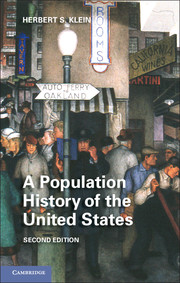Book contents
- Frontmatter
- Contents
- Graphs, Maps, and Tables
- Introduction to the Second Edition
- Introduction to the First Edition
- 1 Paleo–Indians, Europeans, and the Settlement of America
- 2 Colonization and Settlement of North America
- 3 The Early Republic to 1860
- 4 The Creation of an Industrial and Urban Society, 1860–1914
- 5 The Evolution of a Modern Population, 1914–1945
- 6 The Baby Boom and Bust and the New New Immigrants, 1945–1970
- 7 An Advanced Industrial Society, 1970–2011
- Appendix Tables, Graphs, and Maps
- Bibliography
- Index
- References
6 - The Baby Boom and Bust and the New New Immigrants, 1945–1970
Published online by Cambridge University Press: 05 June 2012
- Frontmatter
- Contents
- Graphs, Maps, and Tables
- Introduction to the Second Edition
- Introduction to the First Edition
- 1 Paleo–Indians, Europeans, and the Settlement of America
- 2 Colonization and Settlement of North America
- 3 The Early Republic to 1860
- 4 The Creation of an Industrial and Urban Society, 1860–1914
- 5 The Evolution of a Modern Population, 1914–1945
- 6 The Baby Boom and Bust and the New New Immigrants, 1945–1970
- 7 An Advanced Industrial Society, 1970–2011
- Appendix Tables, Graphs, and Maps
- Bibliography
- Index
- References
Summary
If the pre–World War II period was one in which major changes in mortality and morbidity were most significant, the major theme in the immediate postwar period was the abrupt changes in fertility and migrations that occurred in this period of transition. There were, of course, continued declines in the rates of morbidity and mortality, but these were now more evenly spaced among all age groups owing to the massive introduction of antibiotics. But it was changes in fertility that had the most significant impact on the demographic structure of the nation. In what would prove to be a temporary change in direction with important long-term implications, the national population reversed its century-and-a-half-long secular decline in fertility and began moving toward higher birth rates. By the end of this period, that trend would be reversed and replaced by startling new trends in both fertility and family organization. At the beginning of this period, foreign immigration reached its lowest point in over a century and was replaced by significant African American migration from the South to the urban North and by the migration of island-born Puerto Ricans to the mainland United States. By the end of this era, however, international immigration had completely reversed its trend and a whole new chapter in the history of immigration to the United States began with the participation of new peoples populating the nation. This postwar period was also a time when internal migrations of native-born Americans began to define some new and rather uniquely American patterns in urban settlement, with the rise of the suburbs and the corresponding changes in the inner cities. Finally, this was a period of the most intense African American migration, when the then-largest minority population in the national population ended its massive migration out of the South.
- Type
- Chapter
- Information
- A Population History of the United States , pp. 155 - 184Publisher: Cambridge University PressPrint publication year: 2012



